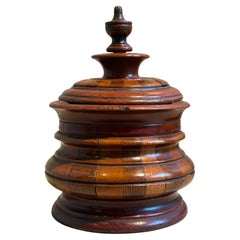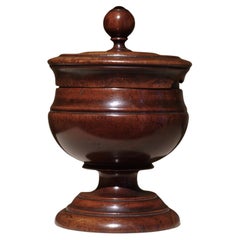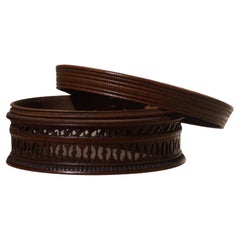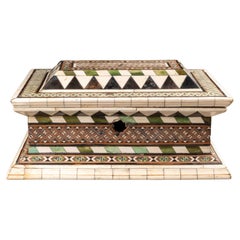Want more images or videos?
Request additional images or videos from the seller
1 of 8
two Dutch Tobacco Jar - 19th century
Price:$1,474.46
About the Item
- Dimensions:Height: 7.49 in (19 cm)Diameter: 6.5 in (16.5 cm)
- Sold As:Set of 2
- Style:Georgian (Of the Period)
- Materials and Techniques:
- Place of Origin:
- Period:
- Date of Manufacture:19th century
- Condition:Wear consistent with age and use.
- Seller Location:Bruxelles, BE
- Reference Number:1stDibs: LU6666238334772
About the Seller
5.0
Vetted Professional Seller
Every seller passes strict standards for authenticity and reliability
1stDibs seller since 2022
15 sales on 1stDibs
Authenticity Guarantee
In the unlikely event there’s an issue with an item’s authenticity, contact us within 1 year for a full refund. DetailsMoney-Back Guarantee
If your item is not as described, is damaged in transit, or does not arrive, contact us within 7 days for a full refund. Details24-Hour Cancellation
You have a 24-hour grace period in which to reconsider your purchase, with no questions asked.Vetted Professional Sellers
Our world-class sellers must adhere to strict standards for service and quality, maintaining the integrity of our listings.Price-Match Guarantee
If you find that a seller listed the same item for a lower price elsewhere, we’ll match it.Trusted Global Delivery
Our best-in-class carrier network provides specialized shipping options worldwide, including custom delivery.You May Also Like
19th Century English Tobacco Jar
Located in MILL, NL
Beautiful 19th century tobacco jar.
In very good condition. Beautiful in colour.
Dimensions: 27,5H x 13ø
Category
Antique 19th Century Snuff Boxes and Tobacco Boxes
Materials
Wood
19th Century English Tobacco Jar
Located in Chicago, IL
A piece that bridges the line between function and quiet artistry, this 19th-century English tobacco jar carries the charm of something handmade, meant to be lived with. Its barrel f...
Category
Antique 19th Century English Folk Art Snuff Boxes and Tobacco Boxes
Materials
Maple, Walnut
19th Century Gentleman Pig Tobacco Jar
Located in High Point, NC
RARE 19th century signed Johann Maresh tobacco jar in the form of a gentleman pig. This is one of those wonderful tobacco boxes you look for to be the star of your collection. He is ...
Category
Antique 19th Century Austrian Victorian Snuff Boxes and Tobacco Boxes
Materials
Terracotta
19th Century Treenware Walnut Tobacco Jar
Located in High Point, NC
19th century hand turned treen tobacco box made from walnut. The lid is expertly turned and is topped with a finial over a fabulous hand turned base. The walnut is a handsome color...
Category
Antique 19th Century English Victorian Snuff Boxes and Tobacco Boxes
Materials
Walnut
19th Century Austrian Terracotta Tobacco Jar
Located in High Point, NC
19th century terracotta tobacco jar from Austria with a gorgeous metallic glaze. The pig is wearing a tasseled hat and overalls with a collared ...
Category
Antique 19th Century Austrian Decorative Boxes
Materials
Terracotta
19th Century Majolica Elephant Tobacco Jar Onnaing
By Onnaing
Located in Austin, TX
Majolica tobacco jar Onnaing, circa 1890.
The two handles are elephants heads, decorated with corn, the handle of the jat is a corn.
Usually in ...
Category
Antique 1890s French Majolica Pottery Cigar Boxes and Humidors
Materials
Majolica
19th Century French Majolica Beehive Tobacco Jar
Located in Austin, TX
19th Century French Majolica Beehive Tobacco Jar.
North of France.
Category
Antique 1890s French Country Decorative Boxes
Materials
Ceramic, Majolica
19th Century French Majolica Log Tobacco Jar
Located in Austin, TX
19th Century French Majolica Log Tobacco Jar.
Category
Antique 1890s French Country Decorative Boxes
Materials
Ceramic, Majolica
19th Century Majolica Elephant Tobacco Jar Onnaing
By Onnaing
Located in Austin, TX
Majolica tobacco jar signed Onnaing, circa 1890.
The two handles are elephants heads, decorated with corn, the handle of the jar is a corn.
Category
Antique 1890s French Majolica Pottery Cigar Boxes and Humidors
Materials
Majolica
19th Century Majolica Goat Tobacco Jar Onnaing
By Onnaing
Located in Austin, TX
Majolica tobacco jar signed Onnaing, circa 1890.
Decorated with a goat and wheat and leaves.
Category
Antique 1890s French Rustic Cigar Boxes and Humidors
Materials
Majolica, Ceramic
More From This Seller
View AllDutch Tobacco Jar - 19th century
Located in Bruxelles, BE
Dutch Tobacco Jar
Netherlands, 19th century
23 x 15 cm
Georgian Dutch Tobacco Jar. Made from different woods, this ring turned Jars show a very nice patina.
Category
Antique 19th Century Dutch Georgian Snuff Boxes and Tobacco Boxes
Materials
Fruitwood
Dutch Tobacco Jar - 19th century
Located in Bruxelles, BE
Dutch Tobacco Jar
Hollande, 19th century
H 18 x diameter 12 cm
Fine Georgian Dutch Tobacco Jar with beautiful patina.
Category
Antique 19th Century Dutch Georgian Snuff Boxes and Tobacco Boxes
Materials
Wood
Turned, Engraved Openwork Box, Florence, 17th Century
Located in Bruxelles, BE
Turned, engraved and openwork box
Fruit wood
Florence, 17th century
Measures: Diameter 11cm
Height 4.4cm.
Category
Antique 17th Century Italian Renaissance Decorative Boxes
Materials
Wood
$767 Sale Price
20% Off
Embriachi workshop marquetry casket - Northern Italy, 15th century
Located in Bruxelles, BE
Embriachi workshop marquetry casket
Northern Italy, 15th century
Alla certosina inlays (bone, stained bone, pewter and wood)
H 28.2 x W 18 x D 14 cm
This beautiful casket of rectangular form is richly decorated with the characteristic geometric patterns of the Embriachi style.
The intricate geometric patterns are fashioned by juxtaposing lighter and darker pieces of wood, (colored) bone, horn and pewter. The lid and base are framed by a broad band of horn. When ivory became scarce in Europe due to disrupted trade routes, bone was substituted.
The attention to Symmetry and balance created an harmonious visual effect
Enhancing the overall aesthetic appeal of the casket.
The application of geometrical motifs is in Italy known as marquetry ‘alla Certosina’, named after the Certosina Church in Pavia with its famous altarpiece decorated in this way. This is ‘intarsia technique’, a term derived from the Arabic 'tarsi', which means ‘incrustation' recalling ancient mosaics made from various materials.
These geometric elements not only enhance the aesthetic appeal of the caskets but also demonstrate the versatility and skill of the artisans in creating multifaceted works of art.
‘Alla Certosina’ became famous through the Northern Italian Embriachi family who achieved a particularly high standard in working in this technique. Venice in particular was known for the production of these luxurious boxes. The caskets, hexagonal or rectangular, surmounted by a lid decorated in several registers constitute the secular, albeit equally renowned component of the workshop’s production, in addition to mirror frames and various everyday objects.
The method of fabrication of those objects was based on two concepts that underlay pre-industrial production: standardization and modularity, thanks to a distribution of skills according to the different phases of fabrication.
even the realization of the marquetry motifs (in the form of ingots from which portions of the desired size were cut) were therefore entrusted to various specialized craftsmen, as were the assembly phase.
Today better known thanks to the extensive research work recently carried out by Michele Tomasi, this workshop owes its name to its founder and owner, the Florentine Baldassare Ubriachi (or degli Embriachi), a merchant and banker established in the Tuscan capital before he settled in Venice in 1395. Together with sculptor Giovanni di Jacopo, who directed the workshop, from the last years of the fourteenth century, Baldassare oversaw a production that was truly original, and still easily recognizable today, comprising monumental altarpieces and various objects, primarily triptychs and caskets.
The precise location of the workshop is unknown, except that it originated in Florence and in ca. 1431 there was apparently a workshop in Venice, in the area of S Luca. They employed local workers specializing in 'certosina' (inlay of stained woods, bone and horn), and the workshop produced items carved in bone (usually horse or ox) with wood and bone marquetry.
The geometric decoration of Embriachi caskets reflects the artistic complexity and attention to detail that characterized their work.
this inlaid casket is a testament to the skill and artistry of the Embriachi family and serves as a stunning example of the decorative arts of the late Middle Ages.
Related Literature :
E. Berger, Prunk-Kassetten: Europäischen Meisterwerke aus acht Jahrhunderten / Ornamental Caskets...
Category
Antique 15th Century and Earlier Italian Renaissance Decorative Boxes
Materials
Pewter
$20,378 Sale Price
22% Off
Free Shipping
Boiled Leather Trunk, Spanish, 17th Century
Located in Bruxelles, BE
Leather trunk
Spanish, 17th century
Boiled Leather, wood and iron
Measures: 22 x 53 x 32 cm.
Provenance :
- collection Metz-Noblat, Château de Clevant, France
Rectangular trunk of the form and size of a small suitcase with wrought iron hinges and lock-plate.
Wood, covered with leather, cut and embossed with every surface of the thick cow hide covered in interlace, zoomorphic features.
The construction method is boiled leather, often referred to by its French translation cuir-bouilli: a process used to change flexible, vegetable-tanned leather into rigid, moulded objects. For shaping of the vegetable-tanned leather, heat and moisture were used, as indicated by the term boiled leather. No written medieval sources describing the production of decorated cuir bouilli objects survive, so knowledge of the process relies on the important studies of the Scottish leather historian John William Waterer. A large range of methods, materials and techniques could be used in various combinations. The vegetable-tanned leather, made supple with moisture and heat, was stuffed, shaped and nailed to the rigid wooden coffer support. The stuffing material was probably modeled beeswax or stearin wax. To shape the leather, to create its topography, « Cushions » were made by lacing a thread through an awl hole and attaching the flexible leather and stuffing to the rigid wooden support on the bottom. Then the decoration was done: lines were incised through the upper layer of the leather (epidermis) with different thicknesses of knives or needles. Contours were created with deep v-shaped cuts, decoration with thin incision and final details with a needle point. For the incision and pouncing stage, the leather was probably kept heated and moistened for suppleness.
Once dry, the leather would be hard and rigid.
the saturated leather is worked over a form, possibly even damp sand, with the pattern shaped using bone or wooden tools. Compare to metal, leather was lighter and it offered protection from cuts and punctures. Cuir bouilli objects were produced by specialist leather workers and needed skillful craftsmanship.
The surface is filled with roundels shaped foliages enclosing animals, lions and peacocks. The foliate arabesques creating a vegetal connection tweet the animals create the impression of a lush verdant space . The vegetal pattern here employed in combination with geometrical pattern came from the pre-islamic artistic traditions of the Byzantine and Sasanian empires. An aspect of Islamic geometry Is the basic symmetrical repetition and mirroring of the shapes that create a sense of harmony.
The decoration of this truck is inspired by the islamic « arabesque » a form of vegetal ornament composed of spirals, intertwining plants and abstract curvilinear motifs. An arabesque character is given to the birds of the decorations through extreme stylisation. This arabesque maintained the classical tradition of median symmetry, freedom in Detail and heterogeneity of ornament.
The presence of the peacocks is a paradisiacal allusion: in popular Islamic literature they were among the original inhabitants of the garden of Paradise expelled with Adam and Eve. Peacock as a decorative motif may have originated in the West, despite their eastern provenance. There was an ancient belief that the flesh and feathers of peacock do not decay. This led to the peacock becoming a christian symbol for Christ’s resurrection.
Renowned for their decorative wall hangings, seventeenth-century Spanish leatherworkers also produced utilitarian objects, such as this trunk. A similar trunk is on display at the Metropolitan museum of art ( 09.158.1).
Related literature :
Davies L. 2006. Cuir bouilli. Conservation of leather and related materials, 94-102, Oxford: elsevier Butterworth-Heinemann
Grabar, Oleg. The Mediation of Ornament. Princeton: Princeton University Press, 1992
Gabriela Germana Roquez, "El mueble en el Peru en el siglo XVIII...
Category
Antique 17th Century Decorative Boxes
Materials
Iron
Pair of Silver Amulets of Two Fantastic Animals, Naples, 18th-19th Century
Located in Bruxelles, BE
Pair of silver amulets of two fantastic animals
Naples, late 18th- early 19th century
Silver, punches and the seal of the Kingdom of Naples
Measures: ...
Category
Antique Early 19th Century Italian Other Collectible Jewelry
Materials
Silver
Recently Viewed
View AllMore Ways To Browse
Antique Snuff Jars
Dutch Tobacco Jar
Art Deco Silver Snuff Boxes
Porcelain Snuff Box Furniture
18th Century Porcelain Snuff Boxes
Antique Porcelain Snuff Boxes
Antique Brass Snuff Box
Antique Snuff Jars
Bilston Enamel
Battersea Bilston
Battersea Box
Battersea Enamel Box
Mother Of Pearl Snuff Box
Antique Battersea Boxes
Austria Snuff Box
Opium Box
Shell Snuff Box
Bilston Enamel Box



